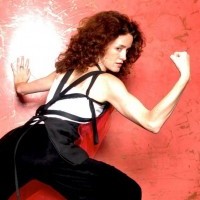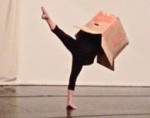
Otro Tango Show
(Just Another Tango Show)
Seductive. Sultry. Intense. Visceral. Passionate. Electrifying. Sensual. Hot. Heady. Raw. The scintillation accrues as I scan the reviews on Tango Fire’s website. Indeed, the critics’ responses are just as exciting, if not more, than the thing itself. That is, if you think “a vertical rape” sounds exciting. One reviewer attributes this depiction of the dance to Jorge Luis Borges, Argentina’s premier contribution to world letters. But Borges had a lot to say about tango, and he was known to change his mind.
The promotional image is no tamer, skirting the line between sexual and grotesque. Lead dancer and choreographer German Cornejo lifts partner Gisela Galeassi’s right leg into an exaggerated back attitude, her foot extending above both their heads. Embracing her from behind, his left hand scoops right up her ribcage, thumb extending into her cleavage, while her breasts threaten to pop out from a dangerously skimpy halter top. Their faces look pained. But my eyes are inevitably drawn to her crotch because that is what the extension reveals. Galeassi is incredibly flexible. At one point in the show, Cornejo lifts her leg in a side extension fully beyond 180 degrees. This is impressive and unsettling at once. Unsettling because as the women’s acrobatics grow ever more spectacular, the men grow ever more aggressive, and the combined energy ever more violent.
Then again, the show is titled Flames of Desire. The production company, Tango Fire. But the acrobatics, the sexual energy, the violence are so hyped up by the end, I leave the theatre simultaneously awed, visually assaulted and psychically drained.
But I am getting ahead of myself.
Like many tango stage shows, Flames introduces the audience to Argentine tango in a two-hour spectacle of live music, dance and song that spans tango’s early days (around the turn of the 20th century) to its more recent incarnations. But Flames is much lighter on the narrative so common to such shows as to be clichéd at this point. Rather than recount Argentine history via scenes of immigrants, knife fights, brothels and slums, Flames puts the dance, music and lyrics center stage. In place of pairings in which the two could pass for grandfather and granddaughter (yet behave like anything but)–par for the course in stage shows–the cast includes five age appropriate couples. This is all refreshing.
The show begins on a sweet note. The only indication of place is a portable conventillo (tenement house) backdrop, though the mood feels more Golden Era neighborhood (1920s-50s) than scandal-ridden slum (1880s-1910s). The men are refined tough guys, the women innocent girls in knee-length floral skirts and white neckerchiefs. The dancing is simple, en el piso (on the floor). The couples walk, execute molinetes (turning grapevines), accent their moves with occasional sacadas (displacements), and initially, introduce few ganchos (leg hooks). The men pay homage to tango’s male-male roots by “practicing” together, one-upping each other’s moves and ultimately trading their male surrogates for female partners. Singer Jesus Hidalgo’s solo guitar serenade, El Dia Que Me Quieras (The Day You Love Me) is a highlight, the show’s most tender moment.
By the close of the first half, however, we have entered gancho land, that moment in the tango show where leg hooks become the defining element. Symbol of combat and naughtiness, the swinging and slicing legs (seemingly incontrollable) have colonized the dance, and the simplicity devolves into spectacle. In the second half, they gancho at one another and on their own, the women’s frenzied gancho fits evoking desperate attempts at flight. The women’s costumes become more scant, their bodies less earthbound. The men are vocal and threatening as they hoist the women in the air, shout at the audience, spin the women around and toss them to the ground.
The partnering is lightning quick and gasp-inducing, given that so much involves women thrown every which way. Noteworthy is Galeassi’s emergence from increasingly violent manipulations unscathed, her poise as unshaken as her extensions extensive. The other dancers, however, occasionally show the strain of such fast and dangerous moves. At times, the women look to be holding on for dear life, but more often the result is merely sloppy feet or unfinished lines. If the men appear stronger overall, the women’s performance is ultimately dependent upon their lead, and difficult to evaluate independent of it. The magic of daring stagework lies in its precision. Visible effort shatters the illusion, and in this context, reveals the misogynistic undertones of aggression mixed with hypersexuality.
What does Flames of Desire say about tango? In the end, it says a lot about one, very popular and quite reductive idea of the form. But Argentine tango can speak of connection, community, sentiment, playfulness, transformation and so much more.
Borges wrote: “The tango can be debated, and we have debates over it, but it still encloses, as does all that which is truthful, a secret.”* What it achieves, it achieves through nuance, suggestion, improvisation, ambiguity. This is difficult territory on a proscenium stage. Still, I’m holding out for the tango show that fully encapsulates Borges’s secret truth.
* “A History of the Tango” (1999) in Selected Non-Fictions (edited by Eliot Weinberger).
Flames of Desire, Tango Fire, Merriam Theatre, October 20.
By Carolyn Merritt
October 28, 2013









